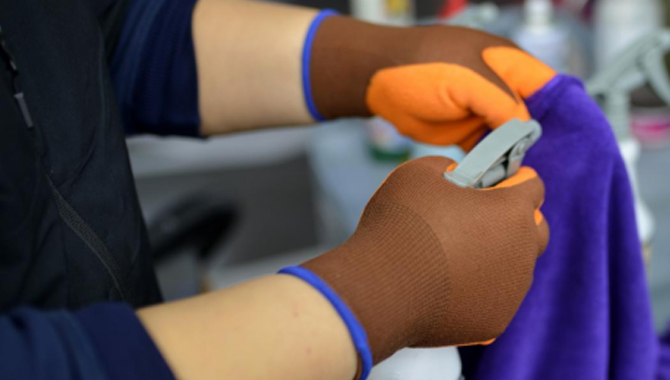Whether in daily life or at work, your hands are often exposed to various dangers without protection. That’s when you need a pair of PPE gloves to quietly safeguard your safety and health. PPE stands for Personal Protective Equipment. The word “glove” refers to an outer protective layer.
But do you really understand them? What types are there? How do you choose and use them correctly? This article will help you quickly and thoroughly understand PPE gloves.
What are Personal Protective Equipment Gloves?
Personal protective equipment gloves are gloves designed mainly to protect the hands from various hazards and are a type of personal protective equipment.
Personal Protective Equipment Gloves
PPE gloves are designed to perfectly protect your hands from injury in any scenario. They are mainly categorized based on materials and application scenarios, but generally, they are broadly classified by material. Specific material classifications are as follows:

Leather Gloves
Leather gloves are primarily made from animal hides such as deerskin, sheepskin, and cowhide. They are favored for their softness and high elasticity. The thickness of the leather provides excellent cold resistance, making them highly effective in cold weather and environments.
Thanks to their unique wear resistance, tear resistance, and puncture resistance, leather gloves are often the best choice for heavy-duty work such as construction and handling tasks. Additionally, they provide a good grip, helping reduce the risk of scratches and abrasions during machining, assembly, and mechanical repairs. They also help reduce fatigue and hand injuries during long driving sessions. In complex and changing work environments, leather gloves can handle tasks with ease, making them a favorite among outdoor enthusiasts.

Cotton Gloves
Cotton gloves are typically made from high-quality cotton fibers. They absorb sweat and wick moisture, offering excellent softness and breathability, making them comfortable to wear for long periods. They are more suitable for light-duty tasks in low-risk environments. Cotton work gloves are also cost-effective compared to other work gloves, offering reliable and affordable hand protection.

Nitrile-Coated Safety Gloves
Nitrile-coated gloves are made by first knitting high-performance materials such as cotton, polyester, or nylon, then coating them with nitrile synthetic rubber. Nitrile itself is resistant to oil, wear, punctures, and chemicals, so gloves made from it possess these same features. They are extremely durable and sturdy.

Polyurethane (PU) Safety Gloves
PU gloves are knitted from blended yarns such as nylon or polyester fibers, with polyurethane (PU) applied to the palms and fingertips to reduce sweating. PU is a lightweight and soft synthetic material, so these gloves are thinner and feel closer to bare hands compared to other types. They are suitable for environments requiring fine operations such as electronics assembly, precision manufacturing, packaging, and sorting.

Latex-Coated Safety Gloves
Latex-coated gloves are also made from high-performance fibers like cotton, polyester, and nylon, and then coated with natural latex. Naturally, these gloves inherit latex’s properties such as waterproofing, anti-slip, wear resistance, and tear resistance. Even in wet or greasy environments, they provide a strong grip. Their elasticity allows them to fit closely to hand contours, offering great flexibility.
However, latex hardens in cold temperatures, reducing its elasticity, so it is not suitable for low-temperature environments. Additionally, some individuals may have allergic reactions to the proteins in natural latex. If you are allergic to latex, it is recommended to choose an alternative glove with similar functions.
 How to Maintain Personal Protective Equipment Gloves
How to Maintain Personal Protective Equipment Gloves
Cleaning
First, determine whether the gloves are washable and reusable. If washable, you can wipe them with a damp cloth or gently clean them with a mild detergent. If they are not water-washable, use a specialized cleaning agent or a dry cloth to wipe them clean. If the gloves are not reusable, dispose of them after use. Refer to the glove cleaning guide provided by the supplier.Drying
After cleaning, it is best to air dry the gloves in the shade. Avoid direct sunlight to prevent material aging or deformation.Inspection
Before each use, check the gloves for holes, cracks, wear, or other damage. If any damage is found, stop using the gloves immediately and replace them.Storage
When not in use, store the gloves in a dry, well-ventilated, and cool place. Avoid moisture, heat, or direct sunlight to prevent unexpected accidents. Also, avoid contact with chemicals, oils, and sharp objects.
Conclusion
There are many types of personal protective equipment gloves, all designed to protect your hands from injury. If you are interested in PPE gloves, please contact us as soon as possible to learn more. These gloves are durable and can keep your hands safe for years to come!
How to Measure Glove Sizes – Source: AIBON
Latex gloves– Source: AIBON
Safety gloves– Source: AIBON
Working gloves– Source: AIBON


 How to Maintain Personal Protective Equipment Gloves
How to Maintain Personal Protective Equipment Gloves